Austin Migration Insights
Sign up for the Central Texas Economy Report newsletter
Posted on 10/08/2020 by Chris Ramser
- Annually since 2010, the Austin metro area gains about 32,000 people a year from domestic migration, 6,850 from international migration, and 16,200 from natural increase.
- Austin ranks first among the top 50 largest metros for new residents as a percent of total population.
- The greatest source of new migrants to the Austin metro is other parts of Texas, although the average annual number of new residents from elsewhere in Texas has decreased and the number from California and New York has increased over the last five years.
- The most significant metro area net contributors to Austin MSA’s annual growth are Houston, Dallas, New York, Los Angeles, and San Antonio.
With the Census 2020 collection finishing this month, state and local officials await the release of population counts. The first official Census 2020 numbers for state and local redistricting purposes are scheduled to be released in March 2021 with more detailed data tables set for release later in 2021 and 2022. Since 2010, Texas has added the most people of any state (3.8 million), compared to second place Florida (2.7 million), and California (2.3 million), according to population estimates. Additionally, Austin is the fastest growing large metro. Time will soon tell if our 2020 population count efforts were effective at capturing our high rate of growth.
Population estimates & net migration

Since the beginning of the decade, the Austin MSA has grown by an average of 55,509 people annually, according to the U.S. Census Bureau’s population estimate program. Much of this growth is attributable to domestic migration, roughly 57.6%, with another 12.3% due to international migration, and 29.1% from natural increase. From 2010 to 2019, the region received an average net gain of 31,969 people annually from other locations in the U.S.
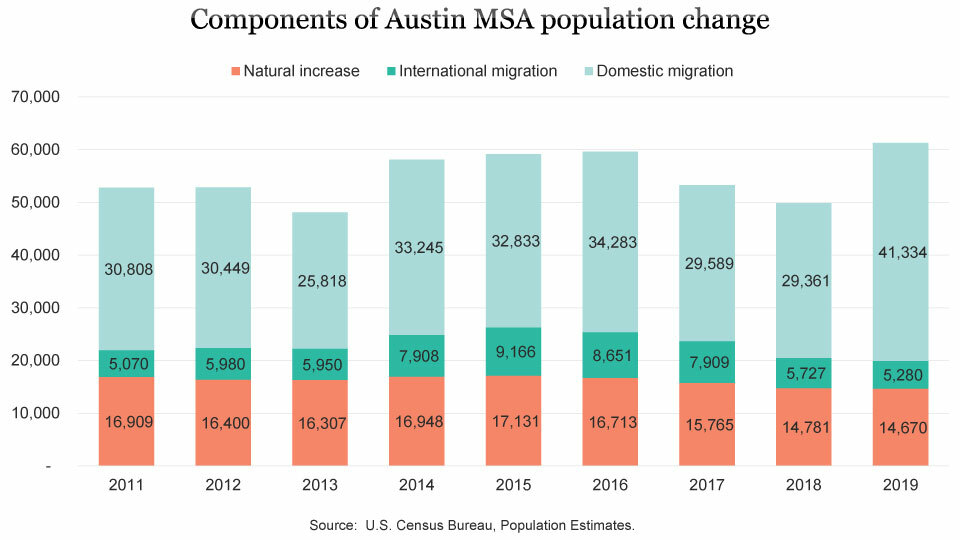
Austin ranks first among the top 50 largest metros for having the greatest share of our total population as new residents. Between 2010 and 2019, Austin added 355,902 net new migrants, or 16.0% of our total 2019 population. Orlando came in second with 14.1% and Raleigh was third with 13.0% of their current population attributed to net migration. San Antonio also made the top 10 with net migration since 2010 accounting for 10.2% of the metro’s total population. Dallas and Houston rank 11th and 13th with 9.1% and 8.5%, respectively. Across all U.S. metros, net migration since 2010 accounts for 3.0% of 2019 population.
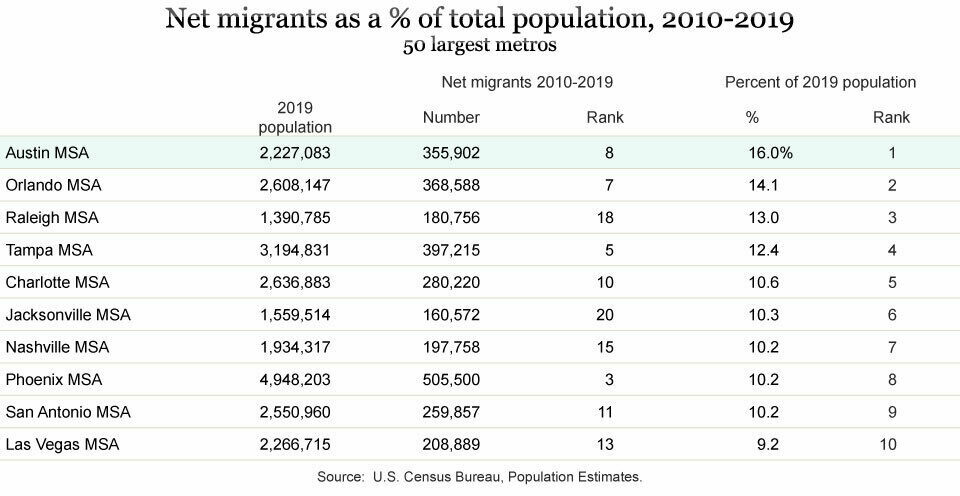
While domestic migration between 2010 and 2019 is the predominate share of migration for Austin, some metros rely mostly on international migration including Miami, San Jose, Boston, and Washington. Several metros would have negative migration but for the infusion of international migrants. Austin was 16th out of the 50 largest metros for international net migration as a percent of total population.
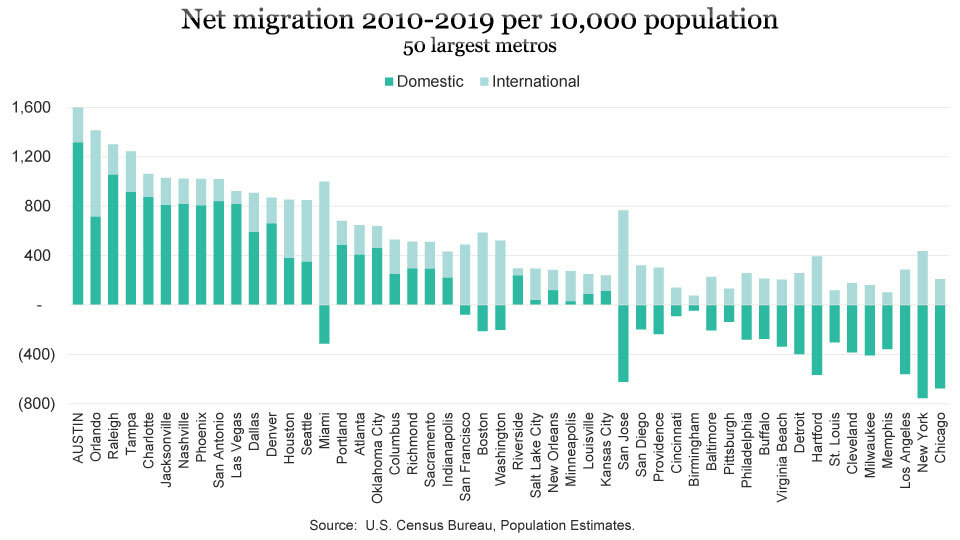
Texas’ growth is nearly evenly divided between natural increase (births minus deaths) and net migration. Texas’ population change from 2018 to 2019 was 47.8% from natural increase and 51.9% from net migration, while Austin’s growth was 23.8% from natural increase and 75.7% from net migration.

The region’s annual growth from 2018 to 2019, as calculated from the Census Bureau’s population estimates, was 61,586, or 169 persons per day. Of this daily number, net migration accounts for 128 and 40 are the result of births exceeding deaths.[1]
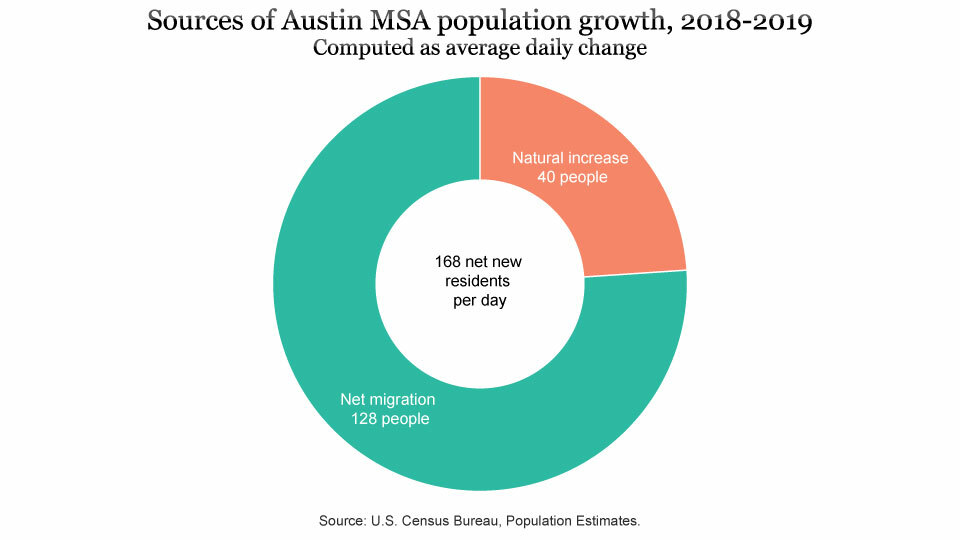
Geographic mobility
Additional insights into migration are provided by the Census Bureau’s American Community Survey (ACS). This annual sample survey, the replacement for the Decennial Census’s “long form” questionnaire, instituted following the 2000 Census, provides data on many demographic, economic, social, and housing characteristics of U.S. residents.
The ACS asks respondents questions about where they lived a year earlier. Of Austin’s 2,202,582 residents one year of age and older in 2019, 145,620 lived somewhere other than in the Austin MSA the year before. That’s 6.6% of Austin’s population and, among major metros, Austin ranks second for “movers in” as a percent of total population.
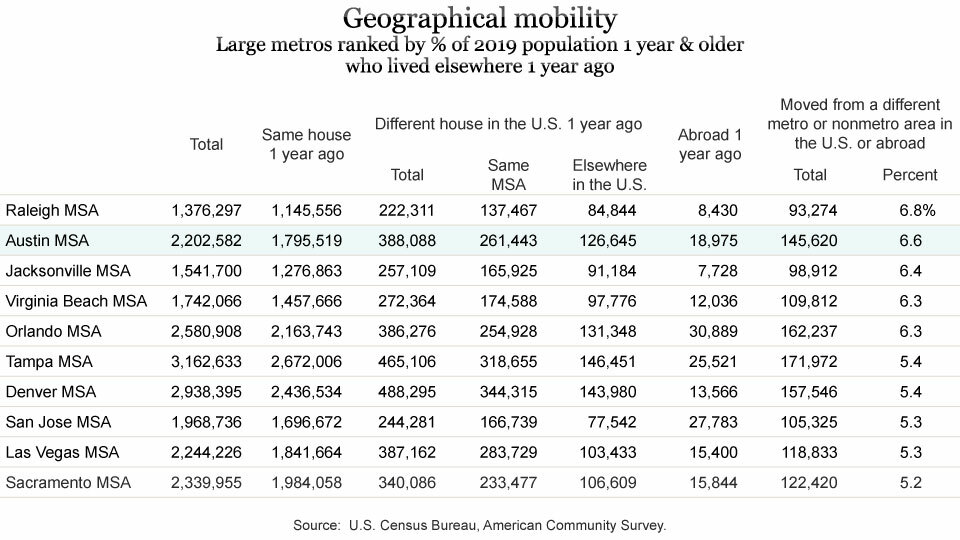
Origin of migrants
The ACS also provides detail on where people move from and move to. Using sample data collected each year, the Census Bureau aggregates 5 years of ACS data to generate estimates of annual migration between each U.S. county and publishes this data in its Census Flows Mapper application.[2] The current version of the map uses samples collected from 2014 to 2018 and estimates represent the annual number of movers during this period.
Data downloaded from Census Flows Mapper shows inbound and outbound flows, as well as net migrants, from a selected county to all other counties in the U.S. and Puerto Rico. Using the metro area aggregated tables, the Austin region received 119,146 domestic inbound migrants,[3] and sent 93,377 outbound migrants to other places, resulting in net migration of 25,769. Inbound flow was dominated by people arriving from other counties in Texas (51.3%), followed by California (8.0%), New York (3.3%), Florida (3.1%), and Illinois (2.3%). Each state that contributed at least 1.0% of inbound migrants to Austin MSA are labeled in the pie chart below. All other states contributed 14.5% of the inbound total.
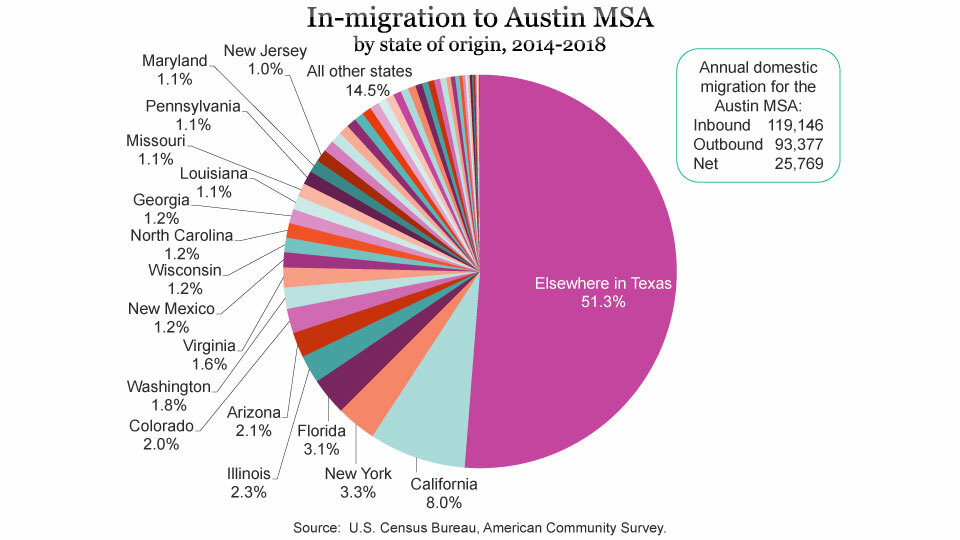
In-migration to the Austin region exceeded out-migration for 36 states, while Austin saw slight deficit flows with 15 states and the District of Columbia—that is, more Austinites departing to than coming from these states. Three states, excluding Texas with 8,806,[4] contributed over 1,000 net migrants each year to Austin, including California (4,966), New York (2,246), and Illinois (1,143) with another nine states contributing over 500 net migrants a year (New Mexico, 986; New Jersey, 797; Wisconsin, 784; Arizona, 783; Massachusetts, 663; Virginia, 631; Florida, 627; Ohio, 549; and Maryland, 507). The states that gained the most residents from Austin were Oregon (-556), Colorado (-336), and Connecticut (-290). Since the information for this release is collected through a sample survey, it is possible that some of the states with smaller net migration totals could be within the margin of error for these estimates, meaning it is impossible to tell if the state’s net migration was actually a deficit or positive flow.

Net migration to the Austin region, while generally robust, has varied somewhat through the years depending on the economic conditions throughout the country. Five years ago (data collected from 2009-2013—around the time of the Great Recession), Austin saw an annual net migration from U.S. states at around 38,412 compared to 25,769 from the most recent release of data from 2014-2018. The top origin states for positive net migration five years ago were elsewhere in Texas, California, Florida, Illinois, Michigan and New York. Now, the states contributing the most gain to Austin still are elsewhere in Texas, California, New York, Illinois, New Mexico, and New Jersey. Migration from California, New York, New Mexico, and Massachusetts appears to have picked up over the last five years. In fact, the Austin MSA is seeing an annual average increase of over 2,100 more Californians and 1,300 more New Yorkers to Austin over the current five-year period compared to the previous five years. Migration from elsewhere in Texas, Florida, Michigan, and Utah has slowed from the levels seen five years ago. The graph below shows a comparison of how the flow of the top states for contributing migrants has changed over the last five years.
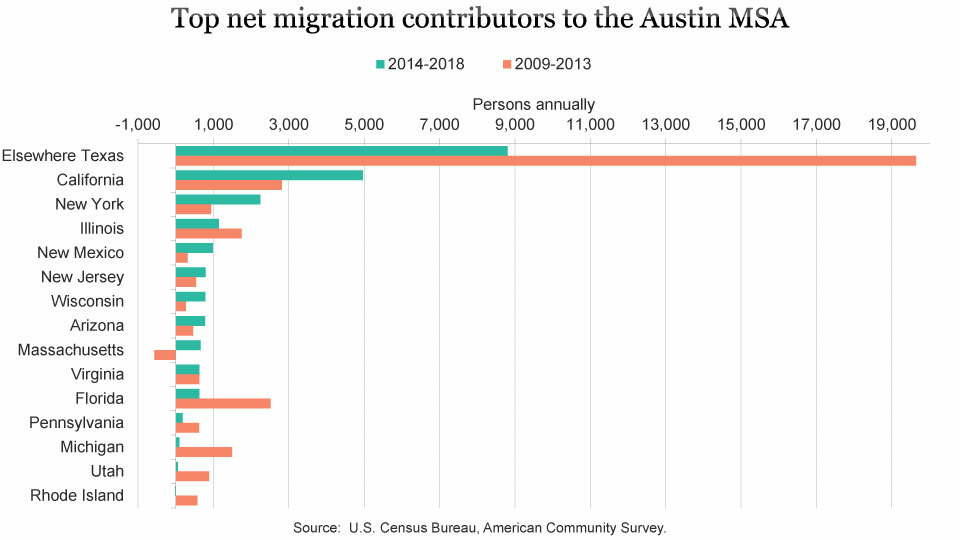
In addition to calculating total flows for the entire Austin metro, we’ve analyzed the migration flows between Austin and other metropolitan areas and produced two tables of the 20 largest positive and deficit flows. Of the top 20 net flows to Austin, six were from fellow metro areas in Texas and five were in California. Topping the list was Houston with a net 4,448 people to Austin each year over the past five years, followed by Dallas with 2,675, and New York with 2,462. Rounding out the top five were Los Angeles (1,964) and San Antonio (1,734). The four other California metros in the top 20 were San Francisco, 801; Riverside, 695; San Jose, 532; and San Diego, 445.
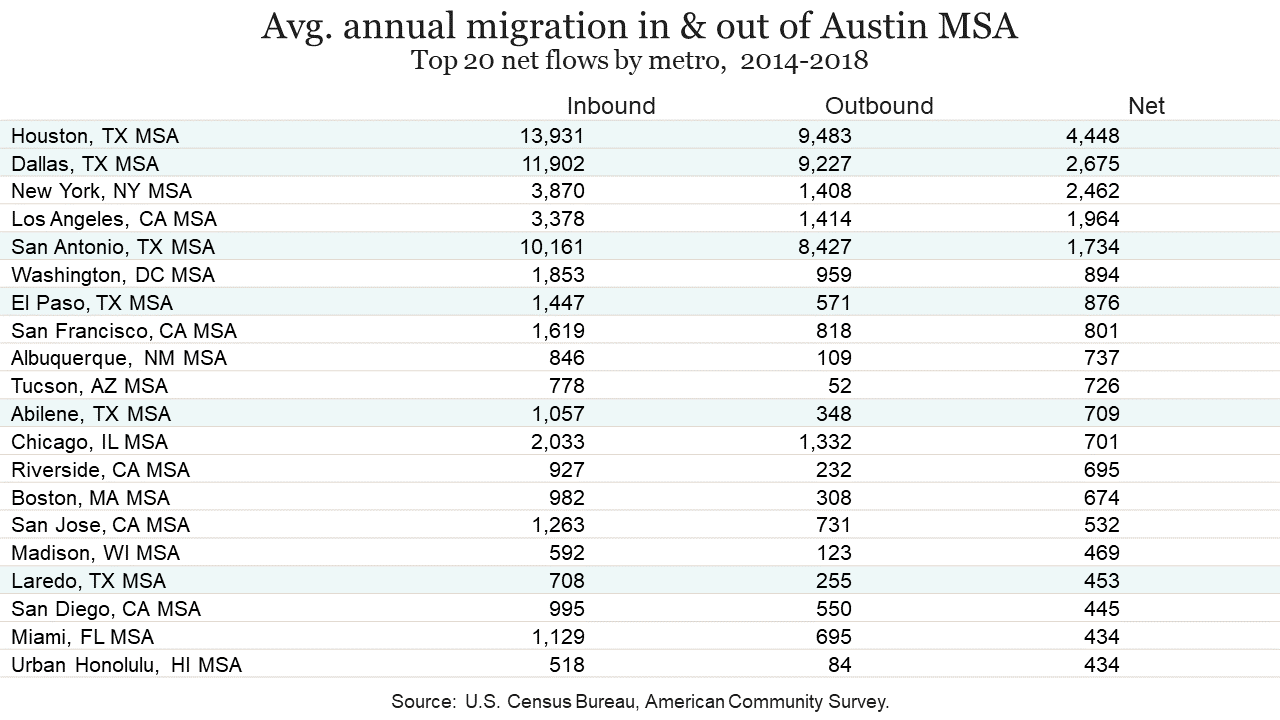
The top 20 metro areas with which Austin has a migration deficit included five Texas metros: Killeen, College Station, Odessa, Waco, and Longview. Killeen was at the top of this list with an estimated annual inbound flow of 3,028 compared to outbound flow of 4,300 resulting in a net deficit of 1,272, while College Station’s net deficit was 913. Rounding out the top five were Denver with a deficit of 589, Portland at 407, and Pensacola, FL at 376.[5] Counties in the U.S. that are not classified within a metro area gained an average net of 788 people each year from the Austin MSA over the past five years.

Other metros with a large volume of in and outbound migrants, but not among the top 20 net positive and deficit flows, were Corpus Christi (1,728 inbound, 1,522 outbound), Phoenix (1,446 inbound, 1,266 outbound), Atlanta (1,037 inbound, 969 outbound), McAllen (922 inbound, 922 outbound), Lubbock (982 inbound, 746 outbound), and Beaumont (806 inbound, 600 outbound). Below is a choropleth map of the net annual migration to Austin for all metros. Areas in purple indicate metros with a deficit flow for Austin while the darker greens are the biggest net migrant contributors.

Analyzing migration between counties within the Austin area is also a possible use of this data. An annual estimate of 45,896 people moved from one county in the Austin metro to another. The below crosswalk table allows for looking up the total number of estimated movers from one metro county to another in the metro area. Start by picking a county from the vertical list of counties labeled “moved out of” and next pick a county from the horizontal list of “moved into” counties, finding the cell where the row and column intersection. For example, 16,942 moved out of Travis and into Williamson. Conversely, 10,147 moved out of Williamson and into Travis.

In addition to these migration data, the Internal Revenue Service (IRS) periodically publishes a dataset of U.S. migration data based on year-to-year address changes reported on individual income tax returns. The most recently available dataset is for 2017-18. The Capital of Texas Media Foundation has analyzed some of the trends from the IRS migration data files in this article.
To download an Excel workbook of several worksheets of the data presented in this article, click here. The file includes a summary table of county, metro, and flows for the Austin MSA region as well as an individual worksheet of county-to-county flows for each of the five Austin MSA counties.
FOOTNOTES:
- Population change also includes a residual component that is not attributable to demographic shifts. The residual component is the result of population controls applied to lower levels of geography or due to incorporation of accepted challenges and special censuses into the population estimates. Sometimes the residual component is sizable enough to be noticeable, however, the residual growth for the Austin MSA from 2018-2019 was only 302. ↩
- Metropolitan area flows are also downloadable in excel from this site. ↩
- These calculations exclude migration to/from Puerto Rico.↩
- The Texas total here represents the non Metro Austin portion of the State, labeled as Elsewhere Texas in the graphs. ↩
- Perhaps underscoring some of the limitations of the data as a result of sample size and potential margins of error is the possible, but curious 0 inbound migration from Boise City, ID, while 163 people were estimated to have moved from Austin to that mid-sized metro of 750,000. When dealing with the type of sample data like the ACS, it is not uncommon to have margins of error in the hundreds range, and upon further examination of the net migration for Austin and Boise, ID, the margin of error was 130, which essentially means the supposed deficit may be anywhere between 33 and 293.↩